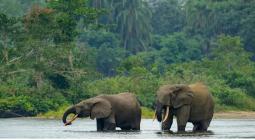Africa’s famous Serengeti and Maasai Mara are being hit by climate change – a major threat to wildlife and tourism
The Mara-Serengeti ecosystem, which includes Kenya’s Maasai Mara and Tanzania’s Serengeti National Park, is one of the most famous and wildlife-rich areas in Africa.
Every year, millions of animals move across the land in search of fresh grass and water, creating an incredible spectacle known as the Great Migration. This migration sustains hundreds of predators and scavengers like vultures. The wildlife is also important for local governments and communities that rely on funds from tourism and conservation efforts.
All this activity – the well-being of wildlife, the water they drink and the vegetation they feed on – depends on weather patterns. Extreme weather phenomena, therefore, can wreak havoc on the workings of the ecosystem.
I’m part of a team from the universities of Hohenheim and Groningen, Free University of Berlin, the IUCN, the Indian Institute of Management in Udaipur and the Kenya Meteorological Department which has been studying weather patterns in the Mara-Serengeti ecosystem since 1913. Our new study has found that it has been experiencing major changes.
Over the past six decades, rainfall has been above average and there have also been recurrent severe droughts, erratic extremely wet conditions and a temperature rise of 4.8°C to 5.8°C.
These events are having a significant impact on wildlife populations and biodiversity in the area. Vegetation and water are gradually drying. Competition between wildlife, livestock and people for resources is increasing. Wildlife numbers are falling and there are changes in patterns of migration and breeding.
Key findings
We have found that the Mara-Serengeti is rapidly warming.
The average monthly minimum temperatures (taken in Narok Town, bordering the Maasai Mara ecosystem) between 1960 and 2024 increased significantly – an overall rise of 5.3°C. The minimum temperature increased from 7.9°C in May 1960, reaching 13.2°C in 2024.
Rainfall in both the Maasai Mara and Serengeti increased over time. Severe droughts are becoming more frequent and intense. And though extreme floods are relatively rare, they’re also increasing in frequency and intensity over time.
What’s driving these changes
By analysing patterns in rainfall and temperature alongside global oceanic and atmospheric climate systems, we connect the weather changes in the Mara-Serengeti ecosystem to climate change. The global climate systems are changing due to global warming.
Specifically, we examined the Southern Oscillation Index and the Indian Ocean Dipole (IOD) between 1913 and 2024. These are the most significant oceanic and atmospheric patterns affecting climate in east Africa.
The Southern Oscillation Index measures the difference in air pressure between two places, Tahiti in the South Pacific and Darwin in Australia. When the sea level pressure difference is big it signals changes – like El Niño (warm phase of the oscillation) or La Niña (cold phase) – which can affect weather patterns around the world. El Niño is linked to more rainfall in east Africa and La Niña to droughts.
The Indian Ocean Dipole is a climate pattern which is like a seesaw for the ocean temperatures in the Indian Ocean. Sometimes, one side of the ocean near Africa gets warmer, while the side near Indonesia gets cooler. Other times, it flips, with Indonesia being warmer and Africa cooler. This changing pattern affects the weather, causing more rain when the ocean near east Africa is warmer and droughts when the ocean is cooler.
Our study of the Southern Oscillation Index found that around 1970 the shifts in oceanic and atmospheric conditions that cause El Niño and La Niña were becoming more extreme. As a result, these events – and the droughts and floods they bring – are happening more often and with greater intensity.
Meanwhile, between 1913 and 2024, the Indian Ocean Dipole has slowly increased due to steady ocean warming. And there are two repeating cycles that happen every 4.1 and 5.4 years. These cycles change in strength and timing, but they keep coming back regularly. The steady strengthening of the dipole is a sign of global warming and altered atmospheric circulation. The increased frequency and intensity of dipole events, when there are warmer sea surface temperatures in the western Indian Ocean, are linked to more frequent and severe floods and droughts in the Mara-Serengeti ecosystem.
Implications of weather changes
The droughts, floods and temperature rise are affecting wildlife populations and biodiversity in the ecosystem.
We’ve seen this through field observations in annual reports by Kenya’s Game Department and its successor, the Wildlife Conservation and Management Department, and from local district documents in the Kenya National Archives and there are also more contemporary observations.
We analysed this observational data to identify trends and patterns in wildlife populations over time, and the timing, scale and location of changes. We then linked these to changes in the weather and specific anomalies, such as droughts.
We also systematically ruled out other potential causes, such as disease outbreaks, habitat destruction, pollution or overexploitation, such as through poaching.
These are some of the impacts from the ecosystem’s changing weather patterns:
-
Droughts kill wildlife through starvation, thirst and dehydration and the increased predation and poaching of weakened animals.
-
Drought is linked to increased human-wildlife conflict because wild animals raid crops, kill livestock and injure or kill people.
-
Droughts intensify the competition for scarce resources among wildlife, pastoralists and their livestock.
-
Droughts temporarily increase carcass availability, boosting predator numbers, but as prey numbers decline, predators face starvation and their numbers decrease.
-
Heavy rainfall replenishes drinking water sources and promotes plant growth, but it also causes wildlife drownings and destruction of habitats.
-
Heavy rainfall after droughts can kill wildlife because sudden severe temperature drops following the onset of rains can be fatal to weakened animals. The rapid growth of young grass can further endanger vulnerable animals due to nutritional imbalance, sudden dietary change and dehydration.
-
Heavy rainfall increases grass biomass and fibre accumulation, thereby depressing nutritional quality for ungulates that thrive best at intermediate biomass levels.
-
Droughts bring diseases, such as anthrax or rinderpest outbreaks, and pathogens, such as parasitic lungworm.
-
Droughts shrink the area of wetlands critical for herbivores during droughts.
-
Heavy rainfall increases the risk of fires by promoting lush grass growth. The excessive biomass dries, ignites and burns.
-
Abundant rainfall can boost breeding but may also increase wildlife death due to diseases and predation in lush conditions.
-
Droughts force wildlife to migrate over longer distances in search of food and water, leading to early departures, delayed arrivals, or movement into dangerous areas, such as near poachers.
-
Heavy rainfall causes animals to roam further from their usual ranges and reduces the number of animals that migrate.
-
Unpredictable rainfall makes animal migrations more erratic, and often mistimed with periods of peak resource availability.
-
Extended droughts suppress reproduction, reducing birth rates, milk availability, and successful mating. This leads to unseasonal calving, reproductive pauses or failures and high mortality among young animals.
-
Droughts delay the onset of births and timing of birth peaks, while good rains advance it.
-
Droughts decrease the number of females that breed and reduce the likelihood of synchronised breeding among females, while high rainfall increases synchrony of births and females that give birth.
Cover photo : A cheetah. J Uriarte/Getty Images




